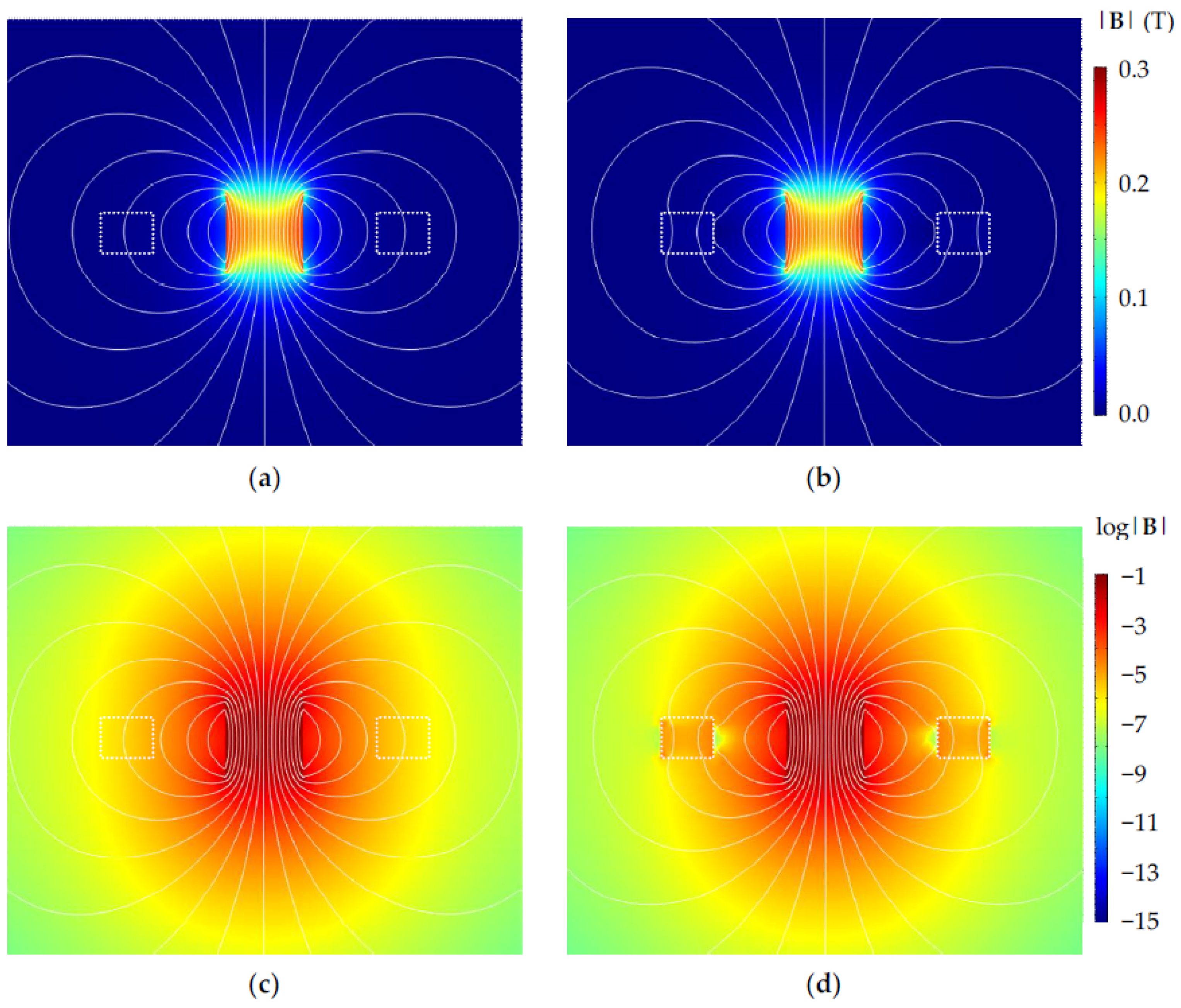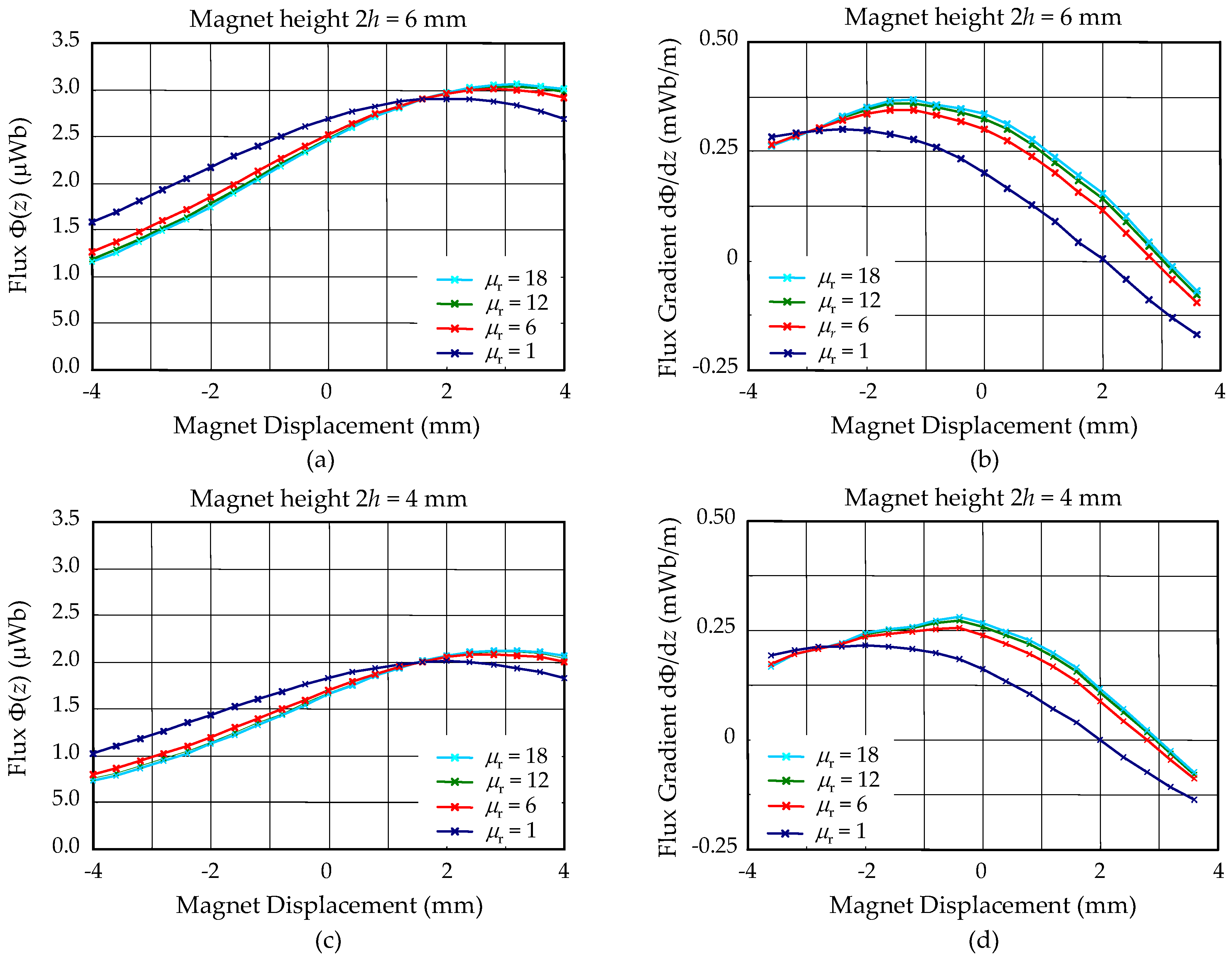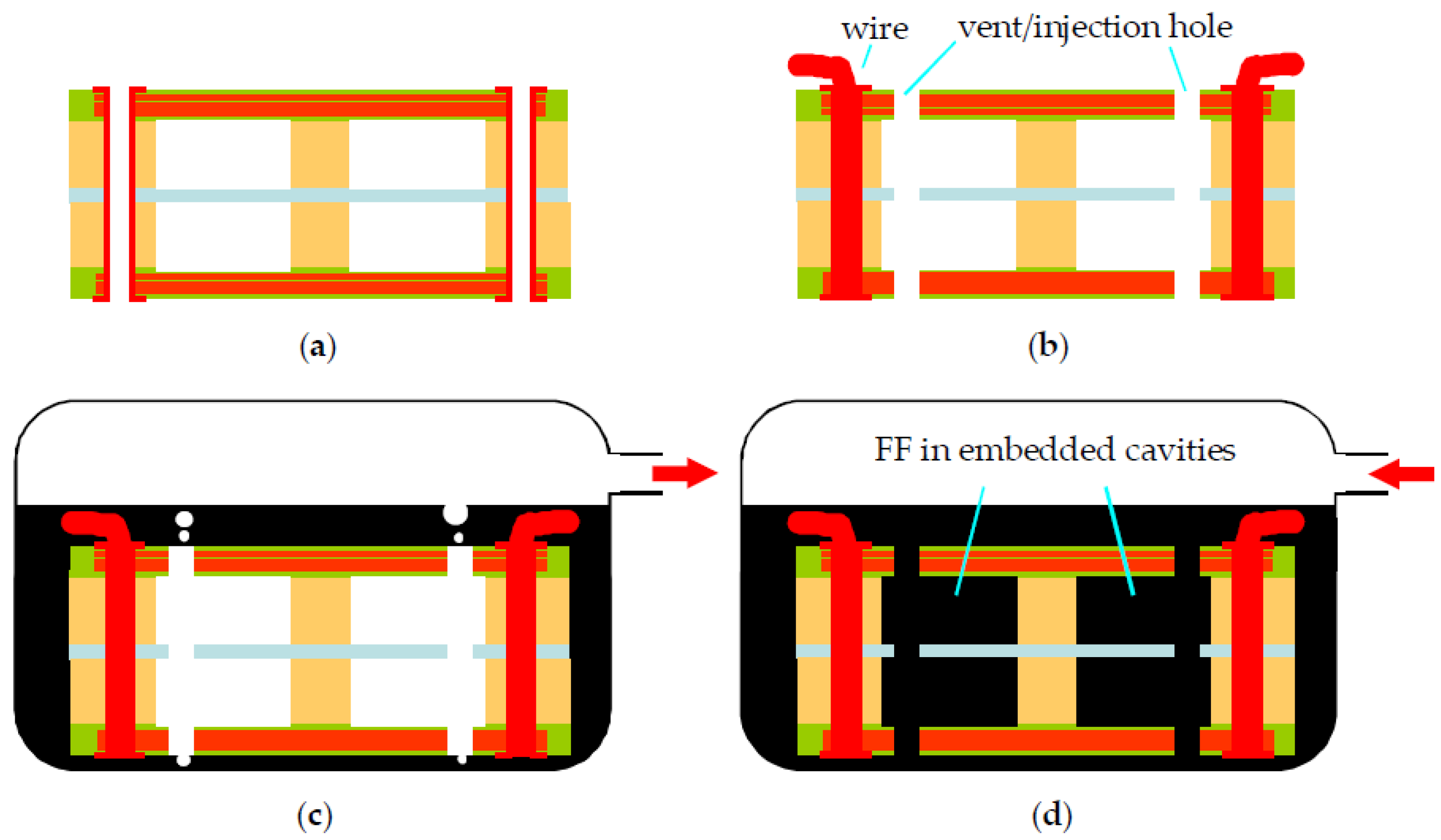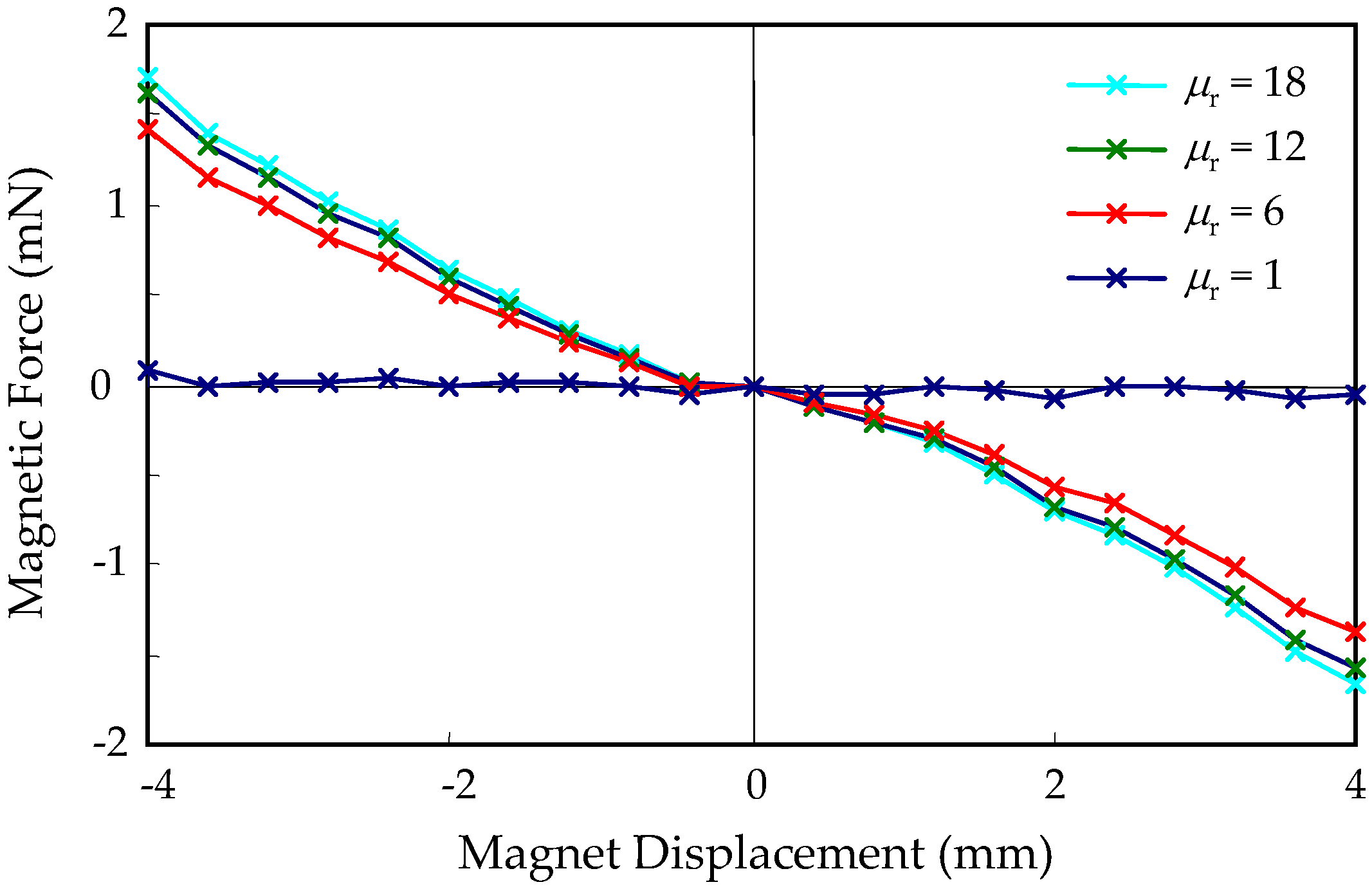Rigid-Flex PCB Technology with Embedded Fluidic Cavities and Its Application in Electromagnetic Energy Harvesters
Abstract
:1. Introduction
2. Principle and Design
2.1. Electromagnetic Energy Harvesters with Embedded Ferrofluid
2.2. Device Design
2.3. Magnetic Field Calculation
- The total flux produced by different magnets was approximately proportional to the magnet height 2h (Figure 4a,c); and
- The total flux reached maximum when the magnet centers were aligned with the coil plane at z = 2 mm. However, the flux gradient dΦ/dz vanishes at this position.
- The total flux when the magnet was near the rest position (z = 0) is lower (Figure 4a,c) whereas the flux gradient at the same position is higher (Figure 4b,d) for devices with FF. The total flux enclosed by the coils had two components, one from inside the magnet, which is positive, and the other from outside the magnet, which is negative. This result indicates that the FF in the cavities contributes more negative flux, relatively, as evidenced by the more perpendicular flux lines shown in Figure 3;
- The positions for peak flux gradient were shifted toward the rest magnet position by the FF for all different device configurations (Figure 4b,d). Particularly, in Figure 4d, the maximum flux gradient was shifted to approximately align with the rest magnet position at z = 0. This indicates that the device with a magnet height of 2h = 4 mm, shown in Figure 4d, was operated at the optimal condition. As discussed in the above, the thickness of the dummy board (and, thus, the thickness of the embedded FF cavities and the position of the transduction coil) can be designed according to this calculation to optimize the device operation conditions and maximize harvester output; and
- The enhancement of the flux and flux gradient was relatively insensitive to the selected range of permeability of the injected FF.
3. Device Fabrication
4. Vibration Tests and Discussion
4.1. Discussion
4.1.1. Normalized Output
4.1.2. Harvester Effectiveness
4.1.3. Effect of High-Permeability Materials on Harvester Characteristics
5. Conclusions
Author Contributions
Funding
Acknowledgments
Conflicts of Interest
References
- Palasagaram, J.N.; Ramadoss, R. MEMS-capacitive pressure sensor fabricated using printed-circuit-processing techniques. IEEE Sens. J. 2006, 6, 1374–1375. [Google Scholar] [CrossRef]
- Cetiner, B.A.; Qian, J.Y.; Chang, H.P.; Bachman, M.; Li, G.P.; De Flaviis, F. Monolithic integration of RF MEMS switches with a diversity antenna on PCB substrate. IEEE Trans. Microwave Theory Tech. 2003, 51, 332–335. [Google Scholar] [CrossRef]
- Podder, P.; Amann, A.; Roy, S. Combined effect of bistability and mechanical impact on the performance of a nonlinear electromagnetic vibration energy harvester. IEEE/ASME Trans. Mechatron. 2016, 21, 727–739. [Google Scholar] [CrossRef]
- Halim, M.A.; Rantz, R.; Zhang, Q.; Gu, L.; Yang, K.; Roundy, S. Electromagnetic energy harvesting from swing-arm motion using rotational eccentric mass structure. In Proceedings of the 19th International Conference on Solid-State Sensors, Actuators and Microsystems (TRANSDUCERS), Kaohsiung, Taiwan, 18–22 June 2017; pp. 1863–1866. [Google Scholar]
- Chen, W.; Cao, Y.; Xie, J. Piezoelectric and electromagnetic hybrid energy harvester for powering wireless sensor nodes in smart grid. J. Mech. Sci. Technol. 2015, 29, 4313–4318. [Google Scholar] [CrossRef]
- Chiu, Y.; Bargayo, R.P.; Hong, H.-C. Stacked electret energy harvesting system fabricated with folded flexible printed circuit board. Proc. PowerMEMS 2012, 2012, 149–152. [Google Scholar]
- Serre, C.; Pérez-Rodríguez, A.; Fondevilla, N.; Martincic, E.; Morante, J.R.; Montserrat, J.; Esteve, J. Linear and non-linear behavior of mechanical resonators for optimized inertial electromagnetic microgenerators. Microsyst. Technol. 2009, 15, 1217–1223. [Google Scholar] [CrossRef]
- Hapitoglu, G.; Ürey, H. FR4-based electromagnetic energy harvester for wireless sensor nodes. Smart Mater. Struct. 2010, 19, 015022. [Google Scholar]
- Chen, J.; Chen, D.; Yuan, T.; Chen, X. A multi-frequency sandwich type electromagnetic vibration energy harvester. Appl. Phys. Lett. 2012, 100, 213509. [Google Scholar] [CrossRef]
- Chiu, Y.; Hong, H.-C.; Hsu, W.-H. Wideband vibrational electromagnetic energy harvesters with nonlinear polyimide springs based on rigid-flex printed circuit boards technology. Smart Mater. Struct. 2016, 25, 125014. [Google Scholar] [CrossRef]
- Chiu, Y.; Hong, H.-C. Electromagnetic energy harvester with embedded ferrofluid in PCB technology. In Proceedings of the 17th International Conference on Micro and Nanotechnology for Power Generation and Energy Conversion Applications (PowerMEMS), Kanazawa, Japan, 14–17 November 2017; pp. 347–350. [Google Scholar]
- Moschou, D.; Tserepi, A. The lab-on-PCB approach: Tackling the μTAS commercial upscaling bottleneck. Lab Chip 2017, 17, 1388–1405. [Google Scholar] [CrossRef] [PubMed]
- Aracil, C.; Perdigones, F.; Moreno, J.M.; Luque, A.; Quero, J.M. Portable Lab-on-PCB platform for autonomous micromixing. Microelectron. Eng. 2015, 131, 13–18. [Google Scholar] [CrossRef]
- Moschou, D.; Greathead, L.; Pantelidis, P.; Kelleher, P.; Morgan, H.; Prodromakis, T. Amperometric IFN-γ immunosensors with commercially fabricated PCB sensing electrodes. Biosens. Bioelectron. 2016, 86, 805–810. [Google Scholar] [CrossRef] [PubMed]
- Wego, A.; Richter, S.; Pagel, L. Fluidic microsystems based on printed circuit board technology. J. Micromech. Microeng. 2001, 11, 528–531. [Google Scholar] [CrossRef]
- Wego, A.; Glock, H.W.; Pagel, L.; Richter, S. Investigations on thermo-pneumatic volume actuators based on PCB technology. Sens. Actuators A 2001, 93, 95–102. [Google Scholar] [CrossRef]
- Liu, H.; Qian, Y.; Wang, N.; Lee, C. An in-plane approximated nonlinear MEMS electromagnetic energy harvester. J. Microelectromech. Syst. 2014, 23, 740–749. [Google Scholar] [CrossRef]
- Galchev, T.; Kim, H.; Najafi, K. Micro power generator for harvesting low-frequency and nonperiodic vibrations. J. Microelectromech. Syst. 2011, 20, 852–866. [Google Scholar] [CrossRef]
- Halim, M.A.; Cho, H.; Salauddin, M.; Park, J.Y. A miniaturized electromagnetic vibration energy harvester using flux-guided magnet stacks for human-body-induced motion. Sens. Actuators A 2016, 249, 23–31. [Google Scholar] [CrossRef]
- Suzuki, Y.; Miki, D.; Edamoto, M.; Honzumi, M. A MEMS electret generator with electrostatic levitation for vibration-driven energy-harvesting applications. J. Micromech. Microeng. 2010, 20, 104002. [Google Scholar] [CrossRef]
- Tvedt, L.G.W.; Nguyen, D.S.; Halvorsen, E. Nonlinear behavior of an electrostatic energy harvester under wide- and narrowband excitation. J. Microelectromech. Syst. 2010, 19, 305–316. [Google Scholar] [CrossRef]
- Chiu, Y.; Tseng, V.F.-G. A capacitive vibration-to-electricity energy converter with integrated mechanical switches. J. Micromech. Microeng. 2008, 18, 104004. [Google Scholar] [CrossRef]
- Erturk, A.; Inman, D.J. An experimentally validated bimorph cantilever model for piezoelectric energy harvesting from base excitations. Smart Mater. Struct. 2009, 18, 025009. [Google Scholar] [CrossRef]
- Shen, D.; Park, J.H.; Ajitsaria, J.; Choe, S.Y.; Wikle, H.C., III; Kim, D.J. The design, fabrication and evaluation of a MEMS PZT cantilever with an integrated Si proof mass for vibration energy harvesting. J. Micromech. Microeng. 2008, 18, 055017. [Google Scholar] [CrossRef]
- Hajati, A.; Kim, S.G. Ultra-wide bandwidth piezoelectric energy harvesting. Appl. Phys. Lett. 2011, 99, 083105. [Google Scholar] [CrossRef]
- Zhang, Q.; Kim, E.S. Vibration energy harvesting based on magnet and coil arrays for watt-level handheld power source. Proc. IEEE 2014, 102, 1747–1761. [Google Scholar] [CrossRef]
- Khan, F.; Sassani, F.; Stoeber, B. Nonlinear behaviour of membrane type electromagnetic energy harvester under harmonic and random vibrations. Microsyst. Technol. 2014, 20, 1323–1335. [Google Scholar] [CrossRef]
- Liu, H.; Gudla, S.; Hassani, F.A.; Heng, C.H.; Lian, Y.; Lee, C. Investigation of the nonlinear electromagnetic energy harvesters from hand shaking. IEEE Sens. J. 2015, 15, 2356–2364. [Google Scholar] [CrossRef]
- Wurz, M.C.; Kleyman, G.; Twiefel, J. Highly-integrated energy harvesting device for rotational applications utilizing quasi-static piezoelectric and electromagnetic generators. Proc. SPIE 2013, 8688, 86881L. [Google Scholar]
- Ahn, C.H.; Kim, Y.J.; Allen, M.G. A planar variable reluctance magnetic micromotor with fully integrated stator and coils. J. Microelectromech. Syst. 1993, 2, 165–173. [Google Scholar] [CrossRef]
- Rombach, P.; Steiger, H.; Langheinrich, W. Planar coils with ferromagnetic yoke for a micromachined torque sensor. J. Micromech. Microeng. 1995, 5, 136–138. [Google Scholar] [CrossRef]
- Kerner, C.; Magnus, W.; Golubović, D.S.; Van Haesendonck, C.; Moshchalkov, V.V. Micron-sized planar transformer for electromagnetic flux guidance and confinement. Appl. Phys. Lett. 2004, 85, 6013–6015. [Google Scholar] [CrossRef]
- Lee, K.-T.; Kim, C.-J.; Park, N.-C.; Park, Y.-P. Improvement of dynamic characteristics for optical pickup actuator by magnetic circuit. Microsyst. Technol. 2003, 9, 232–242. [Google Scholar] [CrossRef]
- Mitcheson, P.D.; Yeatman, E.M.; Rao, G.K.; Holmes, A.S.; Green, T.C. Energy harvesting from human and machine motion for wireless electronic devices. Proc. IEEE 2008, 96, 1457–1486. [Google Scholar] [CrossRef] [Green Version]
- Hoffmann, D.; Kallenbach, C.; Dobmaier, M.; Folkmer, B.; Manoli, Y. Flexible polyimide film technology for vibration energy harvesting. Proc. PowerMEMS 2009, 2009, 344–347. [Google Scholar]
- Mallick, D.; Amann, A.; Roy, S. A nonlinear stretching based electromagnetic energy harvester on FR4 for wideband operation. Smart Mater. Struct. 2015, 24, 015013. [Google Scholar] [CrossRef]
- Challa, V.R.; Cheng, S.; Arnold, D.P. The role of coupling strength in the performance of electrodynamic vibrational energy harvesters. Smart Mater. Struct. 2012, 22, 025005. [Google Scholar] [CrossRef]









| FR-4 Mechanical Frame Size (mm) | ||
|---|---|---|
| Outside | s1 | 20 |
| Inside | s2 | 10 |
| Total thickness | - | 4 |
| FF cavity size (mm) | ||
| Outside | s4 | 18 |
| Inside | s5 | 12.2 |
| Cavity width | (s4 − s5)/2 | 2.9 |
| Gap between cavities | s6 | 2 |
| Cavity depth | - | 3 |
| PI layer (mm) | ||
| Platform size | s3 | 6 |
| Suspension beam width | - | 0.5 |
| Coil (mm) | ||
| Line width | - | 0.1 |
| Line spacing | - | 0.1 |
| Number of turns per layer | n | 15 |
| FR-4 board thickness | - | 0.5 |
| Type | µr | Density (g/cc) | Viscosity (mPa·s) |
|---|---|---|---|
| Oil-based | 18.6 | 1.29 | 60 |
| Water-based | 12.6 | 1.74 | <5 |
| µr | Magnet Size ϕ × 2h (mm × mm) | FF | f0 (Hz) | Voc,max (mVrms) | Pmax (µWrms) | P’max (µWrms/cm2) | (mWb/m) | Vnorm (a.u.) |
|---|---|---|---|---|---|---|---|---|
| 18.6 | 6 × 6 | no | 195 | 20.9 | 0.78 | 0.20 | 0.20 | 20 |
| yes | 196 | 35.9 | 2.30 | 0.58 | 0.34 | 21 | ||
| 6 × 4 | no | 252 | 18.6 | 0.62 | 0.15 | 0.16 | 29 | |
| yes | 246 | 26.5 | 1.25 | 0.31 | 0.27 | 26 | ||
| 12.6 | 6 × 6 | no | 198 | 22.2 | 0.93 | 0.23 | 0.20 | 22 |
| yes | 197 | 27.1 | 1.38 | 0.35 | 0.33 | 16 | ||
| 6 × 4 | no | 256 | 17.7 | 0.59 | 0.15 | 0.16 | 28 | |
| yes | 255 | 20.9 | 0.82 | 0.21 | 0.26 | 21 |
| # | Reference | ϕ (mm) | 2h (mm) | µr | Pout (µW) | m (g) | Arms (m/s2) | Q | f (Hz) | EH |
|---|---|---|---|---|---|---|---|---|---|---|
| 1 | Prior work [10] | 5 | 4 | 1 | 0.34 | 0.57 | 9.8 | 130 | 285 | 1.7 × 10−4 |
| 2 | This work | 6 | 6 | 1 | 0.78 | 1.2 | 9.8 | 130 | 195 | 1.3 × 10−4 |
| 3 | This work | 6 | 6 | 18 | 2.30 | 1.2 | 9.8 | 130 | 196 | 3.8 × 10−4 |
| 4 | [8] | 13 | 6 | -- | 144 | 5.36 | 0.7 | 23.4 | 24.4 | 7.1 × 10−1 |
| 5 | [36] | 6 | 1 | -- | 5 | 0.2 b | 62.3 | 15 c | 390 | 2.1 × 10−3 |
| 6 | [36] | 6 | 1 | -- | 1 | 0.2 b | 7.6 | 15 c | 370 | 2.7 × 10−2 |
| 7 | [37] | -- a | -- a | -- | 0.35 | 0.16 | 6.9 | 33.3 | 244 | 4.3 × 10−3 |
© 2018 by the authors. Licensee MDPI, Basel, Switzerland. This article is an open access article distributed under the terms and conditions of the Creative Commons Attribution (CC BY) license (http://creativecommons.org/licenses/by/4.0/).
Share and Cite
Chiu, Y.; Hong, H.-C. Rigid-Flex PCB Technology with Embedded Fluidic Cavities and Its Application in Electromagnetic Energy Harvesters. Micromachines 2018, 9, 308. https://doi.org/10.3390/mi9060308
Chiu Y, Hong H-C. Rigid-Flex PCB Technology with Embedded Fluidic Cavities and Its Application in Electromagnetic Energy Harvesters. Micromachines. 2018; 9(6):308. https://doi.org/10.3390/mi9060308
Chicago/Turabian StyleChiu, Yi, and Hao-Chiao Hong. 2018. "Rigid-Flex PCB Technology with Embedded Fluidic Cavities and Its Application in Electromagnetic Energy Harvesters" Micromachines 9, no. 6: 308. https://doi.org/10.3390/mi9060308





